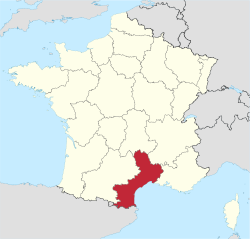
Back Languedoc-Roussillon Afrikaans ላንገዶክ-ሩሲዮን Amharic Lenguadoc-Rosellón AN لنكدوك روسيون Arabic Languedoc-Rosellón AST Languedoc-Roussillon suyu Aymara Langedok-Russilyon Azerbaijani لانقداک روسیون AZB Лангедок-Русільён Byelorussian Лянгедок-Русыён BE-X-OLD
Languedoc-Roussillon
Lengadòc-Rosselhon (Occitan) | |
|---|---|
 | |
| Country | |
| Dissolved | 2016-01-01 |
| Prefecture | Montpellier |
| Departments | 5
|
| Government | |
| • President | Damien Alary (DVG) |
| Area | |
• Total | 27,376 km2 (10,570 sq mi) |
| Population (2012-01-01) | |
• Total | 2,700,266 |
| • Density | 99/km2 (260/sq mi) |
| GDP | |
| • Total | €85.916 billion (2022) |
| • Per capita | €30,400 (2022) |
| Time zone | UTC+1 (CET) |
| • Summer (DST) | UTC+2 (CEST) |
| ISO 3166 code | FR-K |
| NUTS Region | FR8 |
| Website | laregion.fr |
Languedoc-Roussillon (French pronunciation: [lɑ̃ɡ(ə)dɔk ʁusijɔ̃] ⓘ; Occitan: Lengadòc-Rosselhon [ˌleŋɡɔˈðɔk ruseˈʎu]; Catalan: Llenguadoc-Rosselló) is a former administrative region of France. On 1 January 2016, it joined with the region of Midi-Pyrénées to become Occitania.[2] It comprised five departments, and bordered the other French regions of Provence-Alpes-Côte d'Azur, Rhône-Alpes, Auvergne, Midi-Pyrénées towards the north, and Spain, Andorra and the Mediterranean Sea towards the south. It was the southernmost region of mainland France.

